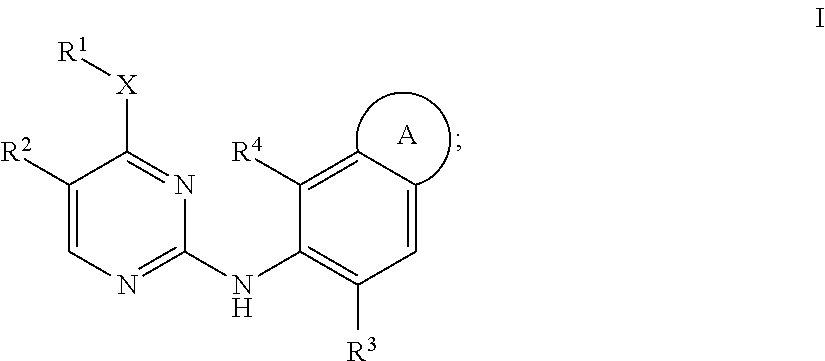Aminopyrimidine derivatives as LRRK2 modulators
a technology of aminopyrimidine and modulator, which is applied in the direction of biocide, antibacterial agents, drug compositions, etc., can solve the problems of trembling, slow movement, and impaired ability to direct and control the movement of the body
- Summary
- Abstract
- Description
- Claims
- Application Information
AI Technical Summary
Benefits of technology
Problems solved by technology
Method used
Image
Examples
examples
[0319]The following preparations and examples are given to enable those skilled in the art to more clearly understand and to practice the present invention. They should not be considered as limiting the scope of the invention, but merely as being illustrative and representative thereof.
[0320]Unless otherwise stated, all temperatures including melting points (i.e., MP) are in degrees celsius (° C.). It should be appreciated that the reaction which produces the indicated and / or the desired product may not necessarily result directly from the combination of two reagents which were initially added, i.e., there may be one or more intermediates which are produced in the mixture which ultimately leads to the formation of the indicated and / or the desired product. The following abbreviations may be used in the Preparations and Examples.
List of Abbreviations
[0321]AcOH Acetic acid[0322]AIBN 2,2′-Azobis(2-methylpropionitrile)[0323]Atm. Atmosphere[0324](BOC)2O di-tert-Butyl dicarbonate[0325]Dave...
preparation 1
2-chloro-5-fluoro-N-methylpyrimidin-4-amine
[0354]
[0355]To a 250 mL round bottom flask equipped with a stir bar was added 9.0 g 5-fluoro-2,4-dichloro-pyrimidine, 40 mL methanol and 15 mL of 8M methylamine in ethanol. The reaction heated up (mild exo-therm) and was allowed to stir at room temperature for ˜30 minutes. A check by TLC (1:1 EtOAc:heptane) and LCMS showed complete reaction. The reaction was concentrated down to give 9.77 g crude material which was purified on a silica column running a gradient of 1% to 10% MeOH in DCM over 35 minutes to give 6.77 g pure 2-chloro-5-fluoro-N-methylpyrimidin-4-amine.
[0356]The same method was used to make the compounds shown in Table 1 below, using the appropriate commercially available substituted 2,4-dichloro-pyrimidines and amines.
[0357]
TABLE 1 12-chloro-5-chloro-N- methylpyrimidin-4- amine 22-chloro-5-bromo-N- methylpyrimidin-4- amine 32-chloro-5-trifluoromethyl-N- methylpyrimidin-4-amine 62-chloro-5-methoxy-N- methylpyrimidin-4- amine 82-...
preparation 2
2,5-dichloro-4-methoxypyrimidine
[0358]
[0359]To a 250 mL round bottom flask equipped with a stir bar was added 1 g 5-chloro-2,4-dichloro-pyrimidine, and 15 mL of diethyl ether. The mixture was cooled to 0° C. in an ice bath and then 1 equivalent of sodium methoxide in methanol (prepared from reacting 120 mg of sodium with 4 mL of methanol at room temperature) was slowly added. The reaction was stirred over night at room temperature and checked by LCMS. The white precipitate was filtered and the solid washed with cold methanol. After drying, 0.98 g of pure 2,5-dichloro-4-methoxypyrimidine was obtained and this material was used without further purification.
[0360]The same method was used to make the compounds shown in Table 2 below, using the appropriate commercially available alcohols and the appropriately substituted 2,4-dichloro-pyrimidines.
[0361]
TABLE 212,5-dichloro-4-ethoxypyrimidine 22,5-dichloro-4-propoxypyrimidine32,5-dichloro-4-isoprpoxypyrimidine65-bromo-2-chloro-4- methoxypy...
PUM
| Property | Measurement | Unit |
|---|---|---|
| temperature | aaaaa | aaaaa |
| temperature | aaaaa | aaaaa |
| temperature | aaaaa | aaaaa |
Abstract
Description
Claims
Application Information
 Login to View More
Login to View More - R&D
- Intellectual Property
- Life Sciences
- Materials
- Tech Scout
- Unparalleled Data Quality
- Higher Quality Content
- 60% Fewer Hallucinations
Browse by: Latest US Patents, China's latest patents, Technical Efficacy Thesaurus, Application Domain, Technology Topic, Popular Technical Reports.
© 2025 PatSnap. All rights reserved.Legal|Privacy policy|Modern Slavery Act Transparency Statement|Sitemap|About US| Contact US: help@patsnap.com



